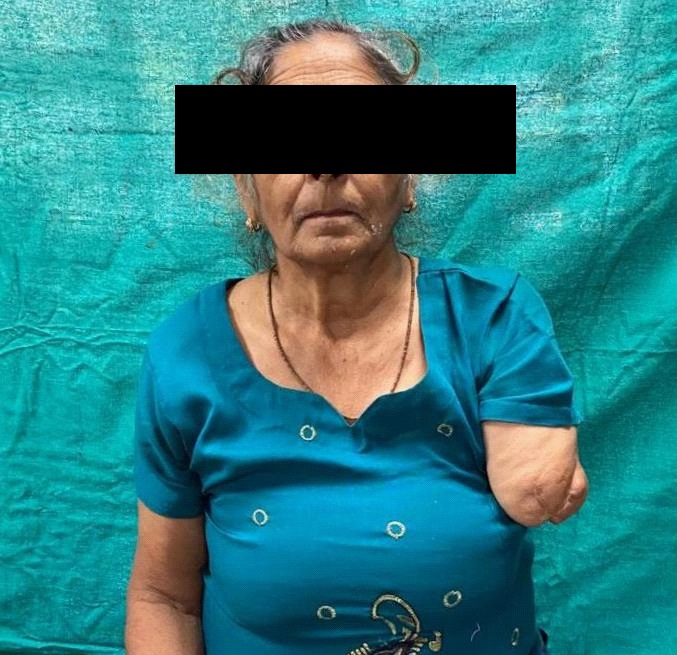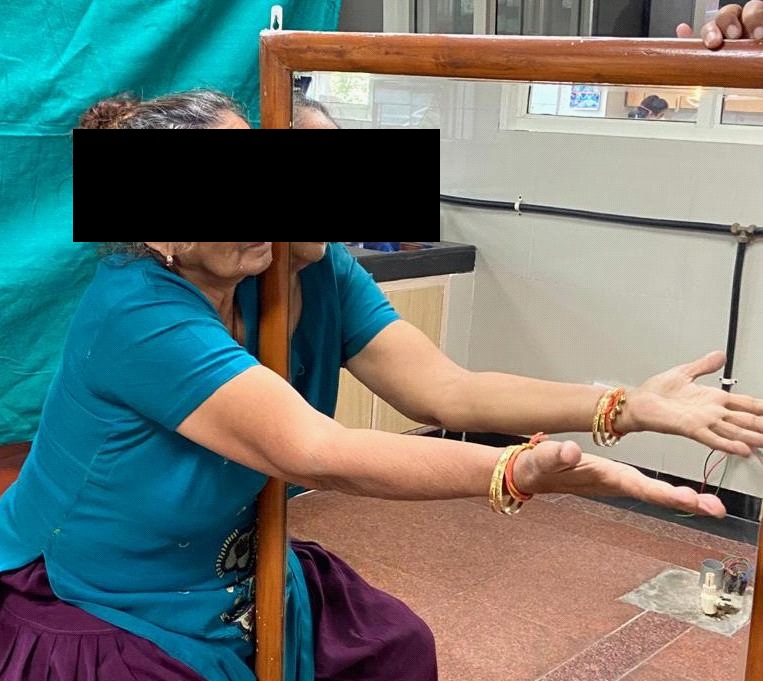
Journal of Clinical Images and Medical Case Reports
ISSN 2766-7820
Case Report - Open Access, Volume 2
Mirror therapy to alleviate Phantom pain
Abhishek Kumar Gupta1*; Rekha Gupta2; Shubhra Gill3; Tanya Grover4
1 Department of Prosthodontics, Maulana Azad Institute of Dental Sciences, New Delhi 110002, India.
2 Head of Department, Department of Prosthodontics, Maulana Azad Institute of Dental Sciences, New Delhi 110002, India.
3 Associate Professor, Department of Prosthodontics, Maulana Azad Institute of Dental Sciences, New Delhi 110002, India.
4 Final year Academic Resident, Department of Prosthodontics, Indraprastha Dental College and Hospital, Ghaziabad 201010, India.
*Corresponding Author: Abhishek Kumar Gupta
Department of Prosthodontics, Maulana Azad Institute
of Dental Sciences, New Delhi 110002, India.
Email: drabhishek.gupta1994@gmail.com
Received : Aug 25, 2021
Accepted : Sep 28, 2021
Published : Oct 05, 2021
Archived : www.jcimcr.org
Copyright : © Gupta AK (2021).
Abstract
Phantom pain is abnormal commotion of crushing, toes twisting, burning, tingling, cramping and shooting pain that is perceived in a body part that has been amputated or no longer exists. The amount of research in few decades has added enormous knowledge in better understanding of phantom pain. The theories of pain pathways have modified over time from mental theory to peripheral and core neural theories together motor-sensory cortical disassociation and tissue reorganization. In the generation of phantom pain, the role of mirror neurons has recently been steered. To alleviate the phantom pain, pharmacological therapy, physical therapy, TENS therapy, neuromodulation, surgical treatment, bio-integrative behavioural methods and Mirror Therapy has been suggested as treatment modalities. However, there hasn’t been a single treatment option until now. In several randomised controlled trials, mirror therapy is used to manage phantom arm pain and had better outcomes. Multidisciplinary approaches are used in the majority of effective clinical results. In this case report mirror therapy has been used to successfully reduce phantom pain.
Keywords: mirror therapy; amputation; mirror neurons; phantom arm pain.
Citation: Gupta AK, Gupta R, Gill S, Grover T. Mirror therapy to alleviate Phantom pain. J Clin Images Med Case Rep. 2021; 2(5): 1341.
Introduction
Phantom pain is characterized by abnormal sensation or pain felt in a body part that has been amputated [1]. Ambrose Pare, A Military surgeon discussed the etiopathogenesis of Phantom Limb Pain (PLP). S.W Mitchell, a Surgeon within the nineteenth century, came up with the term “phantom arm pain” and elucidated the etiology [2]. Common causes of limb amputation includes trauma, vascular disease, necrosis, carcinoma, and congenital limb deficiency. Amputated patients experience PLP ranging from 42.3 to 78.9 percent [3]. Even after extensive research, the exact patho-physiology of PLP is not clear. The central and peripheral neural mechanisms are suggested as pain theories for PLP. Spinal cord sensitization and cortical motor dissociation are some of the central neural theories [4]. Patients perceive phantom pain within a few days of amputation in 75% of cases [5]. It can also happen right after an amputation operation. PLP can be managed either using medicative treatment or surgery. Pharmacological therapy includes anti-convulsants, tricyclic Antidepressants, NMDA receptor antagonist, sodium channel blockers etc [5]. Non-pharmacological Treatment includes TENS therapy, Surgical intervention, Biofeedback, Integrative-behavioral methods and Mirror Therapy. Mirror therapy involves moving the intact limb and observing it in a mirror placed between the limbs, resulting in the simulated limb replacing the phantom limb in the mirror. Mirror neurons in the cerebral coretx activate both when a person performs and watches an activity [6]. When these mirror neurons are activated, they modify somatosensory inputs, inhibit protopathic pain perception in the phantom limb, and decrease pain [7]. Herein, in this case report, mirror therapy was used to successfully alleviate the phantom arm pain.
Case report
A 61-year-old female with amputated arm was referred to department of Prosthodontics with complain of masticatory myalgia. On examination it was observed that, the amputated arm was triggering point for precipitation of pain in TMJ and masticatory muscles. History revealed that the above-elbow amputation was done in left arm in response to gun-shot injury five years back (Figure 1). Phantom pain started 72 hours after amputation and was exacerbated after dental extraction in the past year. Patient’s medical history revealed that patient was suffering from cardiovascular disorder and was put on 75 mg ecospirin for past 10 years. The neurology department prescribed gabapentine (2,400 mg) and amitriptyline (25 mg) for phantom pain. Even after stellate ganglion block was done by neurosurgery department, then also the pain persisted. All treatment modalities provided only short-term improvement and there wasn’t any relief in pain as VAS scale was 8 out of 10 at time of examination. For muscle tenderness in left sternocleido-mastoid, left trapezius and left masseter, EMG (Electromyography) was performed but the results were inconclusive. There was not any spike in left muscles EMG when compared to right muscles. Also, no clear etiology could be found in relation to masticatory myalgia. Hence, a holistic treatment approach was followed for the patient in an effort to treat PLP along with myalgia and to find out any correlation between both. For PLP, Mirror therapy was planned for the patient. She was told to come to the department twice a week and receive a 20-minute therapy. A mirror was placed para-sagitally between the limb and patient was instructed to move the normal arm, and to look towards the phantom arm in the mirror as if phantom arm was moving (Figure 2). After two visits, there was reduction in PLP pain along with the masticatory myalgia, and VAS level was reduced to 5. After one month, both PLP and masticatory myalgia was relieved and her VAS level further reduced to 3. After, three months from the initial therapy, the patient was instructed to perform mirror therapy at home twice a week. The VAS was constant at 3. She is being monitored in our outpatient clinic and is taking gabapentin 1200 mg, which was recommended by the neurology department. A 15-day follow up showed subsequent stable VAS of 3 out of 10. Regular follow-up was done at 4 weeks interval. A follow-up examination at 6 months showed no recurrence of the pain with reduction in muscle myalgia. Patient was advised for follow up at an interval of 3 months for an initial 1 year.
Discussion
There is no single treatment protocol for Phantom arm pain. Numerous treatment modalities exist including pharmacological and non-pharmacological therapies. Drug therapy includes Antidepressants, Pre-emptive analgesics and anaesthetics, Nonsteroidal Anti-Inflammatory Drugs, Anticonvulsants, Opioids and Calcitonin [8]. Gabapentin provides relief in management of Phantom arm pain [9]. Whereas, Non-pharmacological therapy includes Transcutaneous Electrical Nerve Stimulation (TENS), stellate ganglion block, spinal cord stimulation, peripheral nerve block, and mirror therapy, etc [10]. One of the most effective treatment modalities is mirror therapy. In 1996, Mirror therapy was introduced by Rogers-Ramachandran and Ramachandran. In mirror therapy, the patient is instructed to sense and visualize amputated body part functioning as normal body part. The incongruity between proprioception and visual feedback from the severed body part can be reorganised and integrated by reflecting the normal body part in a mirror. As a result, it improves mirror therapy treatment. Studies shows that the treatment using mirror therapy has a greater edge over other treatments [8]. According to Rizzolatti, mirror neurons are the key to mirror therapy [11]. The first mirror neuron was identified in the monkey premotor cortex region of the cerebrum, and Rossi subsequently discovered comparable mirror neurons in the human motor complex. When a person acts and witnesses the identical action being performed by another person, a mirror neuron fires repeatedly. The mirror neuron then imitates the other being's action, as the patient is acting. As a result, viewers can feel both the sensation and emotion of the other while imitating it. Thus, the patient with PLP feels similar sensation in the amputated body part as of the normal body part. It lowers PLP by decreasing inconsistencies in the motor, proprioceptive, and visual complexes. Mirror neurons does not fire in all the individuals. Person with intact limb can only empathize with the actions of amputated limb because of no response of mirror neurons. But in a person with amputated limb, activation of mirror neurons takes place, that creates tactile sensation and modulates somatosensory inputs reducing the phantom arm pain [7]. The mirror therapy is not applicable in all types of pain. Its effect on deep somatic pain is more than that of superficial pain. Reason being the deep tissues are involved in both integrating sensorimotor nerves and creating movements [12]. In this case report, mirror therapy was used which has resulted in significant reduction of pain when all other treatment modalities were insignificant. Moreover, TMJ myalgia was also relieved along with PLP without any active intervention for TMJ pain thus suggestive of referral pain or correlation between two but a detailed research is necessary in the required field.
Conclusion
Phantom arm pain is one of the most prevalent and inexorable entity. The discovery of mirror neurons had added an advantage in better understanding of the pain. Mirror therapy is not only simple, but also easy and can be done at home and even at hospitals. Mirror therapy is an easy-to-apply, effective and economical method used for treatment of phantom arm pain.
Acknowledgements: We would like to acknowledge Dr. Vashi, Maulana Azad Institute of Dental Sciences, New Delhi for helping us with the study
Conflict of Interest: There is no conflict of Interest.
References
- Weinstein SM. Phantom limb pain and related disorders. Neurologic clinics. 1998; 16: 919-35.
- Louis ED, York GK. Weir Mitchell’s observations on sensory localization and their influence on Jacksonian neurology. Neurology. 2006; 66: 1241-4.
- Probstner D, Thuler LC, Ishikawa NM, Alvarenga RM. Phantom limb phenomena in cancer amputees. Pain practice. 2010; 10: 249-56.
- Subedi B, Grossberg GT. Phantom limb pain: mechanisms and treatment approaches. Pain research and treatment. 2011.
- Carlen PL, Wall PD, Nadvorna H, Steinbach T. Phantom limbs and related phenomena in recent traumatic amputations. Neurology. 1978; 28: 211-7.
- Rizzolatti G, Fogassi L, Gallese V. Mirrors in the mind. Scientific American. 2006; 295: 54-61.
- Ramachandran VS, Rogers-Ramachandran D. Sensations referred to a patient’s phantom arm from another subjects intact arm: perceptual correlates of mirror neurons. Medical hypotheses. 2008; 70: 1233-4.
- Weeks SR, Anderson-Barnes VC, Tsao JW. Phantom limb pain: theories and therapies. The neurologist. 2010; 16: 277-86.
- Wiffen PJ, McQuay HJ, Edwards J, Moore RA. Gabapentin for acute and chronic pain. Cochrane database of systematic reviews. 2005.
- Richardson C, Glenn S, Horgan M, Nurmikko T. A prospective study of factors associated with the presence of phantom limb pain six months after major lower limb amputation in patients with peripheral vascular disease. The Journal of Pain. 2007; 8: 793-801.
- Rizzolatti G, Fogassi L, Gallese V. Mirrors in the mind. Scientific American. 2006; 295: 54-61.
- Sumitani M, Miyauchi S, McCabe CS, Shibata M, Maeda L, Saitoh Y, et al. Mirror visual feedback alleviates deafferentation pain, depending on qualitative aspects of the pain: a preliminary report. Rheumatology (Oxford). 2008; 47: 1038- 43.


